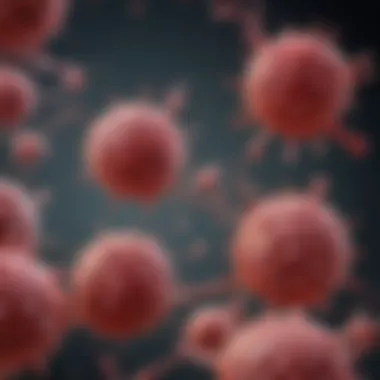Understanding Hemophagocytic Lymphohistiocytosis


Intro
Hemophagocytic Lymphohistiocytosis (HLH) is a condition that not many outside the medical sphere are familiar with, yet it carries significant implications for those who suffer from it. It’s a bit of a mouthful, isn’t it? Essentially, HLH represents a hyperactivation of the immune system, leading to a cascade of inflammatory responses that can be nothing short of catastrophic. Many people might think their immune system is their ally, but in cases of HLH, it can turn against the body itself, launching an attack that can be overwhelming.
Understanding HLH is no simple feat. It is classified into primary and secondary forms, with various triggers that can send the immune system spiraling out of control. From genetic mutations to infections, the factors that can instigate this condition are diverse. As we peel back the layers of HLH in this article, we aim to present a thorough examination of its intricacies, placing a spotlight on its causes, symptoms, and available treatment options.
Article Overview
This exploration offers more than just a glance at HLH; it aims to dig deep into the core of what this condition entails. A significant portion of the discussion centers on its classification, etiology, pathophysiology, and clinical manifestations. By bringing in real-life case studies alongside the latest research findings, we aim to provide not just a theoretical understanding but a comprehensive picture that reflects the current landscape of HLH treatment and management.
Summary of Key Findings
One of the key findings that emerges is the stark contrast between primary HLH, often hereditary, and secondary HLH, which is typically triggered by an external factor. The differences in presentation and management strategies underline the importance of accurate diagnosis. Another essential takeaway is the role of early intervention; recognizing HLH and initiating treatment timely can significantly alter the patient's prognosis.
Research Objectives
This article is not only about unpacking HLH's complexities but also about charting a path for future research. Ongoing studies are crucial, as they hold the potential for novel therapeutic interventions and better diagnostic protocols. Through investigating both case studies and new research, we aim to contribute to the growing body of knowledge surrounding HLH.
Key Results and Discussions
In the subsequent sections, we will dive into the main discoveries about HLH that researchers and clinicians have put forth. This section forms the backbone of our exploration, offering insights that are pertinent to both practitioners and academics in the field.
Main Findings
One can't help but notice the diverse presentations of HLH. Some patients experience a slew of symptoms that can mimic other diseases, leading to potential misdiagnosis and delayed treatment. Reports indicate that the most common symptoms include high fever, splenomegaly, and cytopenias, among others. The striking variability in symptoms underscores the complexity of HLH.
Implications of Findings
The implications of these findings are profound. For medical professionals, recognizing the nuanced presentation of HLH can improve diagnostic accuracy. Furthermore, understanding the triggers can lead to more tailored management strategies. As we continue to explore this topic, it becomes evident that staying informed about HLH and its evolving treatment landscape is essential for fostering better patient outcomes.
Understanding HLH Infection
Hemophagocytic Lymphohistiocytosis (HLH) is not a term that rolls off the tongue easily, yet its implications in the realm of infectious diseases are significant. Understanding HLH infection is crucial for several reasons. Firstly, it sheds light on the intricate dance of the immune system and how it can sometimes spiral out of control, leading to dire consequences. This article aims to equip readers—students, researchers, educators, and healthcare professionals—with a clear understanding of HLH infection, its underlying mechanisms, and its ramifications.
A key area we focus on is the duality of HLH—both primary and secondary. Recognizing the differences between these classifications is essential for effective treatment strategies. Moreover, grasping the historical context of HLH helps situate its current state within the larger framework of medical science, revealing how our understanding has evolved over time.
By laying a solid foundation in understanding HLH infection, we arm our readers with not just knowledge but insight—an essential tool in tackling this complex but critical health issue.
Definition and Overview
Hemophagocytic Lymphohistiocytosis refers to a hyper-inflammatory syndrome characterized by excessive activation of the immune system. At its core, HLH can lead to severe tissue damage due to an overwhelming inflammatory response. It is important to note that HLH is not a disease itself but rather a clinical syndrome caused by various triggers including infections, malignancies, and autoimmune diseases.
The hallmark of HLH is the phenomenon known as hemophagocytosis, where the immune cells, particularly macrophages, begin to engulf red blood cells and platelets, leading to cytopenias. This dysfunction of the immune system often results in symptoms that may look similar to those of other illnesses, making diagnosis a challenge. The complexity of HLH thus resides in its variable presentations and myriad causes, making it a tough nut to crack in terms of treatment and management.
Historical Context
The concept of HLH has a history that dates back several decades. Initially recognized as a consequence of specific infections, the understanding of HLH has broadened significantly. In the 1970s, this syndrome was associated primarily with certain viral infections. However, as more was learned about the immune response, it became apparent that HLH could arise from a variety of sources.
Notably, the classification into primary and secondary HLH was pivotal. Primary HLH, often congenital, happens due to genetic defects, while secondary HLH occurs as a response to infections, malignancies, or autoimmune problems. This delineation not only aids in the identification of treatment protocols but also shapes the research efforts surrounding HLH, as scientists strive to uncover the genetic and environmental underpinnings that contribute to its onset.
HLH is not simply a medical anomaly; it is a window into the complexities of the immune response and its sometimes paradoxical role in protection versus pathology.
Understanding HLH infection requires a blend of clinical insight and biological knowledge, as the history of HLH is woven with threads from various strands of medical science. This historical perspective is invaluable, offering lessons learned that inform current approaches in diagnosis and treatment, ensuring that those suffering from HLH receive the care they need.
Classification of HLH
Understanding the classification of Hemophagocytic Lymphohistiocytosis (HLH) is crucial in unraveling the complex nature of this condition. For healthcare professionals, distinguishing between primary and secondary HLH is vital for accurate diagnosis and treatment approaches. Each classification comes with its own nuances, helping to guide tailored therapies that correspond to the underlying causes.
Primary HLH
Primary HLH, often referred to as familial HLH, is typically rooted in genetic factors. Conditions like Familial Hemophagocytic Lymphohistiocytosis, caused by various inherited gene mutations affecting the immune system, result in uncontrolled inflammation. Families with a history of primary HLH often report an early onset of symptoms, sometimes during childhood. This type of HLH can be life-threatening without timely intervention.
Key Characteristics of Primary HLH
- Genetic Component: Identified mutations in genes such as PRF1, UNC13D, and STX11 predispose individuals to this condition.
- Early Diagnosis: Symptoms usually appear in infancy or early childhood, making awareness essential for families with hereditary risk.
- Management: Treating primary HLH often involves immunosuppressive therapies and, in severe cases, hematopoietic stem cell transplantation.
The clear delineation of primary HLH allows medical practitioners to look for specific genetic markers and design a treatment plan tailored to the familial history.
Secondary HLH
On the other hand, secondary HLH arises from various external factors and underlying conditions. This form can present itself due to infections, malignancies, or autoimmune diseases, among other triggers. Identifying the specific cause is pivotal for effective management and treatment.
Association with Infections
Secondary HLH can be significantly influenced by infectious agents. Viral infections such as Epstein-Barr Virus (EBV) and cytomegalovirus (CMV) have been known to trigger episodes of HLH. This association plays an essential role in understanding the infection's pathway and intervention strategies.
- Key Characteristics: Viruses, particularly EBV, stimulate an aberrant immune response, leading to the activation of macrophages that engulf other blood cells.
- Benefit to Discourse: Highlighting this aspect allows clinicians to remain vigilant for HLH in patients with recent infections, emphasizing early diagnosis.
- Unique Features: The rapid escalation of symptoms in patients with viral infections can present unique diagnostic challenges, necessitating prompt treatment adjustments.
This association underscores the need for healthcare providers to consider infectious etiologies when diagnosing HLH, allows for a proactive approach to patient management.
Connection to Malignancies
Another significant aspect of secondary HLH is its association with malignancies. Cancers like lymphomas and leukemias often lead to a hyper-inflammatory state similar to that seen in HLH. Understanding this connection helps in discerning when malignancy may be a contributing factor in HLH presentations.
- Key Characteristics: Certain cancers induce immune dysregulation, which can mimic HLH, thereby complicating the clinical picture.
- Reason for Exploration: Recognizing HLH as a paraneoplastic phenomenon prompts a comprehensive evaluation of malignancy in affected patients.
- Advantages and Disadvantages: While early identification can improve outcomes, it can also lead to misdiagnosis if the HLH is not viewed in the context of the overall malignancy and its treatment plan.
Addressing malignancies within the scope of HLH classification is crucial as it shapes diagnostic and therapeutic pathways.
Relationship with Autoimmune Diseases
Lastly, the connection of secondary HLH to autoimmune diseases, such as systemic lupus erythematosus (SLE) or rheumatoid arthritis, creates another layer of complexity. In these situations, HLH acts as a secondary response to the dysregulation of the immune system caused by these chronic conditions.
- Key Characteristics: These diseases can cause an overactivation of the immune response, aiding in the development of HLH symptoms.
- Benefits to the Narrative: By discussing this relationship, practitioners can better understand how autoimmune disease courses can intersect with HLH development.
- Unique Features: The ability of autoimmune conditions to exacerbate HLH symptoms highlights the necessity for a tailored therapeutic approach that simultaneously addresses both conditions.
Exploring the relationship between HLH and autoimmune diseases opens avenues for interdisciplinary collaboration, ensuring comprehensive care for patients suffering from both.
Overall, the classification of HLH remains a pivotal concept in this realm, serving to clarify the etiology and informing management strategies effectively. Each type possesses specific traits and challenges that must be considered for optimal patient outcomes.
Etiology of HLH Infection


The etiology of HLH infection is crucial for understanding the multifaceted nature of this severe immune response disorder. HLH can stem from various origins, particularly genetic predispositions and environmental factors. Identifying these components not only assists in diagnosing HLH but also helps healthcare professionals formulate effective treatment strategies. The complexity of the etiology is both a challenge and an opportunity for advancements in research and clinical practice.
Genetic Factors
Familial HLH Genetics
Familial HLH represents an inherited form of HLH, where specific gene mutations are passed down through generations. The most notable genes associated with this condition include PRF1, UNC13D, STX11, and STXBP2. Understanding Familial HLH genetics is indispensable as it highlights how certain populations are more susceptible to HLH due to their lineage.
The key characteristic of Familial HLH is its autosomal recessive inheritance pattern, meaning that an offspring must inherit one mutated gene from each parent to manifest the disease. This not only helps in patient education but also encourages relatives to undergo genetic testing for early identification and preventive measures.
One unique feature of Familial HLH is that it often presents at a young age, typically under the age of two, making awareness critical for pediatric populations. However, this genetic form carries disadvantages as well; delays in diagnosis can lead to serious complications and a poor prognosis if not managed promptly.
Gene Mutations Identification
Identifying gene mutations is a fundamental aspect of diagnosing HLH. Modern genetic testing techniques, such as next-generation sequencing, allow for rapid identification of mutations linked to HLH, providing pivotal information for initiating targeted therapies.
The ability to rapidly identify gene mutations also plays a significant role in counseling families about their risk factors and potential transmission to future offspring. Gene mutations identification leads to personalized medicine, a beneficial aspect in managing HLH cases.
However, the unique feature of genetic testing is that it often requires a multi-disciplinary approach, involving geneticists, hematologists, and immunologists, making coordination vital. The disadvantage stems from the accessibility of these tests; not all healthcare centers can offer advanced genetic services, which may delay diagnosis in less equipped locations.
Environmental Triggers
Environmental triggers can significantly influence the onset of HLH infection by interacting with genetic predispositions. Factors such as viral infections and microbial pathogens can act as catalysts for HLH, pushing an already susceptible immune system into hyperreactivity.
Viral Infections
Viral infections are often the first-line environmental trigger for secondary HLH. Specifically, viruses such as Epstein-Barr virus (EBV) and cytomegalovirus (CMV) have been frequently associated with the activation of HLH. The overwhelming immune response following viral exposure can lead to the devastating consequences characteristic of HLH.
The key characteristic is the timing; many individuals with EBV may not experience symptoms until months after the initial infection, posing challenges in identifying the link between the virus and HLH onset. This aspect makes viral infections a critical focus for clinicians.
Viral infections can be both useful and detrimental in the context of HLH management. They can serve as indicators for underlying immune dysfunction, allowing healthcare professionals to address the root cause of symptoms. However, the downside is that not every case of HLH will have a clear viral trigger, complicating the diagnostic and therapeutic landscape.
Microbial Pathogens
Microbial pathogens also contribute to the environmental triggers associated with HLH. Bacterial, fungal, or parasitic infections can instigate similar immune responses as seen with viral infections. The diversity of these pathogens, which ranges from common bacteria to rare fungi, can create a complex web of factors at play.
A hallmark feature of microbial pathogens in HLH is their ability to provoke inflammation in a way that mimics the hyper-inflammatory state of HLH. This is often tested against the backdrop of a patient’s medical history for better context.
Microbial pathogens can act as valuable markers for HLH triggers. Recognizing these infections can provide a direct path to managing HLH effectively by treating the underlying infection. On the flip side, the risk lies in misdiagnosis; broad-spectrum treatments may mask the symptoms of HLH rather than addressing its causes.
It is essential to consider both genetic and environmental factors when evaluating HLH infection. This multifaceted approach enriches understanding and facilitates better treatment pathways.
Pathophysiology of HLH
The pathophysiology of hemophagocytic lymphohistiocytosis (HLH) serves as a cornerstone in understanding this profoundly impactful condition. At its core, HLH represents a rapid and exaggerated immune response leading to rampant inflammation, tissue damage, and organ dysfunction. Grasping the intricacies of how HLH unfolds can shed light on potential therapeutic targets and diagnostic markers, making it a crucial focus.
Immune System Dysfunction
Role of Cytokines
Cytokines are small proteins that play a pivotal role in cell signaling, acting as messengers between cells of the immune system. In the context of HLH, the overproduction of certain cytokines, particularly interleukin-6 (IL-6) and tumor necrosis factor-alpha (TNF-alpha), significantly contributes to the syndrome's manifestation. These cytokines are notorious for precipitating intense inflammatory responses.
The key characteristic of cytokine activity in HLH is its duality – beneficial yet perilous. On one hand, cytokines are essential for mounting an immune defense; on the other, their unchecked release leads to systemic hyper inflammation, which can be lethal. Thus, they stand as a prime suspect in HLH, highlighting the need for understanding their regulation.
One uniqueness about cytokines is their local and systemic impact. While they are produced at the site of infection, they can also circulate widely, affecting distant organs. This aspect highlights both their advantages in fighting infection and the stark disadvantages when uncontrolled, leading to complications such as multiple organ failure.
Impact of Hyper inflammation
Hyper inflammation is a hallmark of HLH that can wreak havoc on the body. Essentially, it refers to an exaggerated immune response that causes an overactive inflammatory state, resulting in significant tissue damage. When the immune system perceives an invader, its gears turn rapidly; however, in HLH, these gears become overheated.
A key characteristic of hyper inflammation is its self-perpetuating nature. Once initiated, this state can create a vicious cycle where the inflammation fuels further cytokine release, leading to more inflammation. It's a runaway train, fueled by the immune system's desire to eradicate perceived threats while simultaneously harming the body's tissues and organs.
The unique feature of this hyper inflammatory response lies in its indiscriminate nature. Rather than selectively targeting pathogens, abnormal levels of cytokines can lead to collateral damage, affecting healthy tissues. This can result in severe manifestations such as hepatosplenomegaly and potential neurological deficits, further complicating the clinical picture of HLH.
Hematological Changes
Hematological changes during HLH are not just bystanders in the narrative but rather critical players reflecting the underlying pathophysiological turmoil. Patients frequently experience cytopenias, which are reductions in blood cell counts as the body struggles to cope with the excessive immune activation. This can include anemia, leukopenia, and thrombocytopenia – disruptions that can lead to serious complications like bleeding tendencies and increased infection risk.
In summary, the pathophysiology of HLH encompasses a complex interplay of immune dysfunction and hematological derangements. By unraveling these connections, we gain critical insights that illuminate the path forward in HLH diagnosis and treatment.
Clinical Presentation of HLH
The clinical presentation of Hemophagocytic Lymphohistiocytosis (HLH) is pivotal in understanding this complex immune condition. By recognizing the hallmark symptoms and the disease's progression, healthcare providers can more readily diagnose and initiate appropriate treatment strategies. The details here not only underscore the significance of early detection but also highlight how specific symptoms can shape patient outcomes and influence the management plan.
Symptoms and Signs
Fever
Fever is often one of the first signs that something is amiss in patients suffering from HLH. It's a classic response that signals the body is fighting an underlying infection or inflammation. The key characteristic of fever in this context is its persistent nature, which tends to be higher than normal and can fluctuate throughout the day.
This symptom's prominence makes it a beneficial focal point in the article, as it serves not just to highlight disease activity, but also to draw a line toward the urgent need for comprehensive evaluation. A unique feature of fever in HLH cases is that it doesn't typically respond well to standard antipyretics. This resistance can flag a more serious condition, underscoring the diagnostic challenge clinicians face.
Advantages: Recognizing fever can mobilize swift diagnostic efforts to uncover potential triggers of HLH, such as infections or malignancies.
Disadvantages: The systemic inflammatory response can overshadow or mimic other conditions, potentially leading to misdiagnosis if not considered alongside additional symptoms.
Hepatosplenomegaly
Hepatosplenomegaly, which refers to the enlargement of the liver and spleen, is another hallmark sign of HLH. This symptom often correlates with the underlying processes of hemophagocytosis and immune activation. The noteworthy aspect of hepatosplenomegaly is that its presence indicates significant systemic involvement, reflecting the severity of the disease process.
This characteristic makes hepatosplenomegaly a critical point for discussion in the article as it can aid in narrowing down diagnostic possibilities and focusing investigative efforts on HLH. A unique aspect to consider is its negative impact on organ function, which can result in additional complications like jaundice or abdominal pain.
Advantages: Identifying this symptom can prompt immediate imaging studies and laboratory tests to assess the underlying causes.
Disadvantages: In some cases, hepatosplenomegaly can be attributed to various factors unrelated to HLH, making it necessary to contextualize this symptom within the broader clinical picture to avoid diagnostic pitfalls.
Disease Progression
The progression of HLH encompasses a range of clinical manifestations that increase in severity if left unrecognized or untreated. Understanding how the disease evolves is essential for clinicians aiming for successful outcomes.


HLH typically progresses through distinct phases:
- Initial Phase: Initially, patients may exhibit mild symptoms that can easily be dismissed as viral infections or flu-like illnesses.
- Acute Phase: As the condition advances, symptoms intensify, resulting in severe systemic symptoms, including persistent fever and hepatosplenomegaly.
- Critical Phase: In late-stage HLH, multi-organ dysfunction may occur, requiring urgent interventions to prevent life-threatening consequences.
Anticipating the progression allows for timely interventions, potentially reducing morbidity and mortality associated with HLH. With a solid grasp of the symptoms and signs, healthcare proponents can directly address each element, ensuring they are prepared to guide patient care effectively.
Diagnostic Criteria for HLH
Understanding the diagnostic criteria for Hemophagocytic Lymphohistiocytosis (HLH) is paramount to effectively tackling this complex condition. This intricate process begins with recognizing the telltale signs and symptoms that warrant further examination. These criteria not only guide clinicians in diagnosing HLH but also pave the way for timely intervention. By having a comprehensive grasp of these guidelines, healthcare professionals can ensure that patients receive the right treatment without unnecessary delays, ultimately improving outcomes.
Diagnostic Guidelines
The diagnosis of HLH is primarily informed by the criteria set out in the HLH-2004 guidelines. These criteria are a blend of clinical symptoms, laboratory findings, and histopathological examination. They focus on various clinical aspects and laboratory values, including:
- Fever: Continuous or recurrent fever with no obvious infection.
- Hepatosplenomegaly: Enlargement of the liver and spleen.
- Cytopenia: Low blood cell counts, affecting red, white cells, and platelets.
- Hypertriglyceridemia and hyperferritinemia: Elevated triglycerides and ferritin levels in the blood.
- Increased soluble CD25: This marker is indicative of activated T-cells.
- Hemophagocytosis: Direct observation of blood cell phagocytosis in bone marrow or other tissues.
Once a patient exhibits a sufficient number of these criteria, clinicians may suspect HLH, leading to further testing and potential treatment. This strategic approach guarantees that the diagnosis is accurate and rooted in well-established standards.
Laboratory Findings
Cytopenia
Cytopenia refers to the reduction in the number of blood cells, which can be a crucial indicator in diagnosing HLH. This decrease often affects various blood cell types, manifesting as anemia (low red blood cells), leukopenia (low white blood cells), and thrombocytopenia (low platelets). One of the defining characteristics of cytopenia is its multi-faceted nature—meaning the presence of one deficiency often hints at broader systemic issues.
Cytopenia is significant for this article as it provides vital clues to the ongoing immune dysfunction occurring in HLH. Its detection can prompt clinicians to investigate further, filtering through other potential conditions. This characteristic makes cytopenia a strong contender for initial diagnostic steps. However, while cytopenia can provide valuable insight, it is essential to consider that it can be influenced by a host of other factors, making it a bit tricky to interpret in isolation.
Excessive Ferritin Levels
Alongside cytopenia, the presence of excess ferritin levels serves as another crucial laboratory finding associated with HLH. Ferritin is a protein that stores iron, and its heightened levels often signify severe inflammation or tissue damage. In the context of HLH, excessive ferritin can serve as a biomarker, aiding in diagnosis and tracking disease progression.
What sets excess ferritin apart is its correlation with disease severity—the higher the ferritin, the more intense the inflammation, and the greater the immune response. It is especially insightful in differentiating HLH from other inflammatory diseases, as high ferritin levels are less common in those conditions. Yet, highlighting the downside, elevated ferritin levels can also arise in various other scenarios, so clinicians must interpret these results in conjunction with other findings to avoid misdiagnosis.
The diagnostic criteria for HLH are a vital reference for clinicians, ensuring that those affected receive timely and appropriate care.
In summation, the diagnostic criteria for HLH serve as a necessary piece of the puzzle in identifying this potentially life-threatening condition. Robust laboratory findings including cytopenia and excessive ferritin levels act as pivotal indicators. Ensuring that healthcare professionals remain alert to these criteria can help improve diagnosis accuracy and patient management.
Treatment and Management
Effectively managing Hemophagocytic Lymphohistiocytosis (HLH) is crucial as it directly impacts patient outcomes and quality of life. Treatment strategies are designed to suppress the inappropriate immune activation that characterizes HLH, ultimately restoring immune system balance. It’s essential to recognize the spectrum of treatment options available, which can significantly vary based on whether HLH is classified as primary or secondary. The successful management of this condition often combines immediate interventions to control symptoms with long-term strategies aimed at addressing underlying causes.
First-line Therapies
Corticosteroids
Corticosteroids are a cornerstone in the treatment of HLH. They work primarily by dampening the hyperactive immune response, reducing inflammation and preventing further tissue damage. In most cases, high-dose corticosteroids like dexamethasone are administered initially.
One of the key characteristics of corticosteroids is their rapid action, which allows for near-immediate alleviation of symptoms such as fever and organ dysfunction. This makes them a popular choice for clinicians facing the potentially rapid deterioration of patients with HLH.
A unique feature of corticosteroids is their ability to induce apoptosis in activated T cells and macrophages, helping to restrict the exaggerated immune process that is at the heart of HLH. However, it's worth noting that prolonged use can result in significant side effects, including risk of infection, individuals’ diabetes, and osteoporotic fractures. This factor necessitates diligent monitoring and, often, the addition of other immunosuppressive agents to create a more balanced treatment regime.
Immunosuppressants
Immunosuppressants also play a vital role in HLH management, particularly when corticosteroids alone are inadequate or when there’s a need to wean off steroids to minimize side effects. This category includes agents like cyclosporine and etoposide, which help in further controlling the immune response.
Immunosuppressants can be incredibly effective due to their capacity to target specific components of the immune system rather than the broad action of corticosteroids. Their unique feature is the ability to prolong immune tolerance, helping to curb both inflammatory and autoimmune responses in patients. However, caution must be exercised as these agents increase the risk of opportunistic infections, which can complicate the clinical picture in already vulnerable patients.
Advanced Treatment Options
Hematopoietic Stem Cell Transplantation
When standard therapies fail, hematopoietic stem cell transplantation (HSCT) may offer hope for patients with HLH, particularly those with underlying genetic conditions or refractory HLH. HSCT aims to reconstitute the immune system by infusing healthy stem cells from a compatible donor.
A key characteristic of HSCT is its potential to offer a curative solution by replacing defective hematopoietic cells. The unique feature here is that it can effectively reset the immune system, which sometimes remains dysfunctional even after aggressive treatment with medications. While transplantation holds significant promise, it also brings about a heightened risk of complications such as graft-versus-host disease and infections, which necessitates careful pre-transplant evaluation and post-transplant management.
Biologic Therapies
Biologic therapies are an emerging area in the management of HLH, focusing on targeted therapy that interferes with specific pathways of inflammation and immune activation. Agents like anakinra, which targets interleukin-1, aim to mitigate the hyper-inflammatory response without broadly suppressing the immune system.
A significant characteristic of biologic therapies is their tailored approach, which allows for a more precise intervention in the disease process, potentially offering an avenue for patients who do not respond to conventional therapies. Yet, this targeted nature also raises questions about the long-term effects and the complete understanding of how these therapies interact with the complex immune system in HLH patients.
"The key to managing HLH effectively often lies in a comprehensive strategy that addresses immediate symptoms while not losing sight of underlying causes."
As research progresses, a greater understanding of HLH pathology may lead to innovative treatments and improved outcomes for afflicted individuals.
Challenges in HLH Treatment
The treatment of Hemophagocytic Lymphohistiocytosis (HLH) presents a veritable minefield of challenges for clinicians. The complexity of the disease, often overlapping with various conditions, requires a nuanced approach. Recognizing the unique attributes of each patient is crucial to tailor effective treatment strategies.
Earlier sections highlighted the multifaceted nature of HLH, yet treatment resistance and the management of comorbidities stand out as critical elements. These issues not only complicate the therapeutic landscape but also have tangible implications on patient outcomes.
Effective management of HLH necessitates a clear understanding of these challenges. It's not merely about administering the right medication; it’s also about understanding why some treatments fail and what alternative methods might be employed to address stubborn cases. Success in HLH treatment ultimately hinges on a flexible approach that adapts to the ever-changing nuances of the patient’s condition.
Treatment Resistance
Identifying Resistant Cases
Identifying resistant cases in HLH is paramount for refining treatment protocols. These cases often exhibit a failure of conventional therapies, which can stem from several factors, including genetic predispositions or incomplete understanding of the disease's multifactorial nature. One standout characteristic of resistant HLH is the unpredictability in response to standard therapies such as corticosteroids and immunosuppressants. This unpredictability poses a significant challenge.
The contribution of identifying resistant cases is aligned with improving clinical outcomes and optimizing therapeutic strategies. By closely monitoring patients who do not respond to initial treatment, clinicians can gather invaluable data that may inform future directions in HLH therapy. This identification process not only reveals potential underlying issues but also equips researchers and practitioners with insights to explore alternative interventions.
Simply put, if doctors can pinpoint why certain cases resist treatment, they can tailor strategies that increase the likelihood of positive outcomes. This highlights the important feature of resistant case identification: it's diagnostic and therapeutic, enhancing the understanding of HLH while pushing the envelope of treatment possibilities.
Alternative Approaches
In light of the hurdles presented by treatment resistance, exploring alternative approaches becomes an attractive avenue. This encompasses innovative strategies that diverge from standard care, such as experimental therapies or clinical trial participation. The key characteristic of alternative approaches lies in their ability to offer hope when traditional methods fall short, making them a resourceful choice in this narrative.
What sets these alternatives apart is not only their atypical methodologies but also their potential to harness newer technologies, ranging from novel biologics to targeted therapies. While they may involve risks, the unique angle of examining these alternative approaches allows for a deeper exploration into uncharted territories of HLH treatment.
The fine print? Patients and physicians must weigh the advantages against the disadvantages, such as availability or insurance coverage, before proceeding with these options. Implementing these approaches can pave the way for breakthrough advancements in HLH management.


Managing Comorbidities
Comorbidities frequently complicate the picture of HLH. Patients often present with additional health conditions like autoimmune diseases or infections, making it crucial for health care providers to develop comprehensive management strategies. The intersection of HLH with other illnesses presents not just a challenge but a requirement for integrated care.
It is essential to recognize how one condition may exacerbate the other. For instance, an autoimmune disease can create a hyper-inflammatory state that aggravates HLH, making careful management critical. Understanding this relationship can lead to better treatment outcomes as a holistic approach is applied.
"The complexity of HLH treatment can’t be overstated. Each layer of challenge adds another dimension to patient management, requiring healthcare providers to constantly adapt strategies."
Practitioners are advised to routinely assess comorbid conditions throughout the course of treatment, ensuring that interventions address all facets of the patient’s health. Integrating multimodal strategies allows for a better-balanced approach, enhancing the likelihood of reaching a favorable resolution to the myriad challenges that HLH presents.
Ongoing Research and Future Directions
The field of Hemophagocytic Lymphohistiocytosis (HLH) is developing rapidly, with ongoing research playing a crucial role in enhancing our understanding and treatment of this complex condition. This ongoing investigation tackles various aspects of the disease, from identifying new biomarkers to advancing genetic research. The importance of these efforts cannot be understated, as they shed light on HLH's multifaceted nature and help tailor management strategies to meet individual patient needs.
Current Clinical Trials
Clinical trials are vital in evaluating new treatment modalities and refining existing therapies for HLH. These trials help uncover novel approaches that could significantly enhance patient outcomes. Early-stage trials often focus on small groups to test safety, and as confidence builds, larger studies follow to assess effectiveness. Some clinical trials are directed towards exploring immunotherapies and tailored medication regimens, which aim to modulate immune responses more effectively.
Moreover, these trials are pivotal for understanding how different patient demographics respond to treatments. Factors such as age, underlying health conditions, and ethnicity can influence treatment outcomes. By gathering data from diverse populations, researchers can develop more inclusive and universally effective approaches to manage HLH.
Advancements in Understanding HLH
New Biomarkers
In recent years, the focus on identifying new biomarkers has gained traction. These biological indicators can help in diagnosing HLH more quickly and accurately. New biomarkers may allow for earlier intervention and more tailored therapies based on individual patient profiles. The special thing about these biomarkers is that they often reflect the underlying pathophysiology of HLH, which helps in understanding its triggers and progression better.
However, the journey to integrating these biomarkers into practical clinical use is not without its challenges. Some biomarkers might not be universally applicable across different populations or genetic backgrounds. Hence, more studies probing into their specificity and sensitivity are needed.
Genetic Research Developments
Genetic research is another focal point in the ongoing exploration of HLH. This branch of study aims to unravel genetic predispositions and mutations associated with the condition. By identifying specific genetic markers, researchers can better predict which individuals are likely to develop HLH, especially in familial cases.
A remarkable aspect of this research is the potential it holds for gene therapy. Although still in its nascent stages, the goal is to develop therapeutic strategies that could correct genetic defects linked to HLH. Alongside the advantages, challenges remain, primarily concerning the ethical implications and medical regulations surrounding genetic interventions.
Case Studies
Case studies play a pivotal role in understanding Hemophagocytic Lymphohistiocytosis (HLH) infection. They offer real-world instances that highlight the complexities of diagnosis and treatment in various patient populations. Through the examination of individual cases, one can glean valuable insights that help inform clinical practices and enhance the knowledge base surrounding HLH. It’s here that theoretical knowledge meets practical experience, shining a light on the nuances that often elude straightforward clinical guidelines.
To illustrate, distinct case studies reveal variations in clinical presentation and treatment outcomes tied not just to different causes of HLH, but also to patient factors such as age, pre-existing conditions, and genetic predispositions. These cases serve a dual purpose: they inform healthcare providers and help patients understand their conditions better.
Moreover, analyzing notable pediatric or adult cases provides a treasure trove of knowledge, allowing researchers and practitioners to draw connections and identify trends or potential treatment protocols that might not emerge from larger studies alone. By unpacking these stories, we narrow down on specific aspects such as:
- The timeliness of diagnosis.
- Treatment efficacy against particular etiologies.
- The role of supportive care in overall management.
"Understanding HLH through well-documented cases offers a deeper lens into its multifaceted nature, linking theoretical knowledge with practical application."
Ultimately, case studies act as a crucial bridge—connecting theoretical frameworks with tangible outcomes. They transcend the limitations of traditional studies, painting a more vivid picture of HLH infection and its management.
Notable Pediatric Cases
Pediatric HLH cases often present unique challenges due to the complexities of diagnosing and managing this severe condition in children. For instance, a notable case involved a seven-year-old with recurrent fevers and unexplained cytopenia, which had puzzled multiple specialists. After extensive testing, the child was ultimately diagnosed with primary HLH, triggered by a genetic mutation previously unknown in the family. This case underscored the importance of genetic testing in pediatrics since traditional markers for HLH may not always be indicative in younger populations.
Furthermore, another pediatric example illustrated how timely intervention can significantly alter disease trajectory. A three-year-old presented with symptoms that mirrored an ordinary viral infection, yet progressed rapidly to multi-organ failure. The rapid initiation of immunosuppressive therapy not only stabilized the child but also led to a favorable outcome long term. Through these accounts, we learn that early recognition of HLH, particularly in the pediatric demographic, is paramount. It also raises the point of customizing treatment protocols to fit the unique needs of younger patients, sparking further research and innovations.
Adult HLH Scenarios
The landscape of adult HLH cases offers a different set of variables that deserve attention. Many adult cases are linked to underlying diseases like infections or malignancies. One dramatic case involved a 45-year-old diagnosed with HLH secondary to an advanced lymphoma. Initial presentations mimicking a flu pushed the patient through a myriad of misdiagnoses. Only after developing jaundice and severe thrombocytopenia did the healthcare team reconsider their approach, leading to further comprehensive testing.
This instance reveals the crucial role of thorough diagnostic criteria in adults, which may need to include more invasive measures to reach conclusions sooner. Another case highlighted how comorbid conditions, such as diabetes and chronic kidney disease, complicated treatment regimens, often necessitating a tailored multipronged approach involving both oncological and hematological expertise.
These adult scenarios emphasize the complexity of HLH as a condition that not only demands immediate attention but also a collaborative approach across various medical specialties to improve patient outcomes. Insights drawn from these cases provide invaluable lessons about potential pitfalls in diagnosis and treatment. They reinforce the notion that while HLH may be rare, its ramifications can be profound and far-reaching.
Patient Education and Support
Understanding Hemophagocytic Lymphohistiocytosis (HLH) requires not only medical knowledge but also an emphasis on patient education and support. This aspect plays a vital role in empowering both patients and caregivers to navigate the complexities associated with the condition. When individuals affected by HLH are provided with adequate education regarding their condition, they become active participants in their treatment processes. This can lead to better outcomes and improved quality of life, as knowledge equips them to recognize symptoms, understand treatment options, and identify the right moments to seek medical attention.
Education about HLH encompasses various topics, including the pathophysiology of the disease, potential triggers, treatment regimens, and strategies for managing symptoms. By articulating these key concepts with clarity, healthcare providers can demystify HLH for patients and their families. With such understanding, patients are more likely to adhere to treatment guidelines, engage in open communication with their healthcare providers, and remain vigilant for warning signs of disease flare-ups. These proactive measures contribute significantly to disease management and overall wellness.
Support is equally critical, as those affected by HLH often face emotional and psychological challenges throughout their healthcare journeys. Access to reliable support networks can provide an essential buffer against feelings of isolation and anxiety, common among patients dealing with chronic and acute illnesses.
"Education and support are not just adjuncts to treatment; they are essential for effective disease management."
Guidelines for Patients
For patients diagnosed with HLH, it is crucial to follow several guidelines that enhance care and foster comfort. Here are some key recommendations:
- Understand Your Condition: Familiarize yourself with HLH—the symptoms, triggers, and potential complications. Knowledge is power, and being informed helps in making sound health decisions.
- Maintain Communication with Your Healthcare Team: Regular check-ins with your physicians and nurses can ensure that changes in your condition are promptly addressed. Don’t hesitate to voice concerns about treatment side effects or changes in symptoms.
- Adhere to Treatment Protocols: Stick to prescribed medications and follow dietary and lifestyle recommendations. This adherence not only assists in controlling symptoms but also aids in mitigating exacerbations.
- Monitor Symptoms Closely: Keep a journal or log of your symptoms, treatment responses, and any new occurrences. This chronicling allows for informed discussions with healthcare providers and better management.
- Engage in Supportive Practices: Consider practices such as mindfulness, gentle exercise, or nutrition that bolster physical and emotional well-being. They can assist in coping with the health challenges of HLH.
Support Networks
Support networks can be invaluable for individuals dealing with HLH. The psychological and emotional burden of navigating a rare disease can be heavy, and having a community can ease this weight. Here are some forms of support available:
- Family and Friends: Lean on your close circle—they can provide emotional backing, assist with daily tasks, and offer companionship that is often needed during treatment.
- Patient Advocacy Groups: Organizations dedicated to HLH and related disorders can provide resources, educational materials, and avenues for connecting with others who share similar experiences.
- Online Forums and Social Media: Engaging with peers through platforms like Reddit and Facebook can foster community. These spaces allow for sharing stories, advice, and emotional support.
- Mental Health Resources: Don’t underestimate the importance of mental health. Many patients might benefit from speaking with a counselor or therapist who understands chronic illness dynamics.
By proactively engaging in patient education and connecting with robust support networks, individuals with HLH can navigate their condition with more confidence and resilience.
The End
In our exploration of Hemophagocytic Lymphohistiocytosis (HLH), it becomes clear that the complexities surrounding this infrequent but perilous condition warrant careful attention. Throughout the article, we've dissected HLH from multiple angles—its definitions, classifications, and underlying causes, as well as the profound implications of diagnosis and treatment. Understanding HLH is not merely an academic exercise; it's crucial for practitioners and researchers who aim to save lives, particularly due to this condition’s often rapid progression and high mortality rate.
The key elements highlighted in this section emphasize the necessity of early recognition and intervention. Furthermore, our investigation reiterates the importance of individualized patient management strategies that can greatly influence outcomes.
Given its multifactorial nature, HLH challenges healthcare professionals to consider a multidisciplinary approach in both treatment and research. Delving into case studies reinforces our knowledge base and underscores the significance of continual inquiry into this condition. As we advance, the consideration of ongoing trials and developments stands to reshape our understanding and strategies surrounding HLH.
"The study of HLH is not just about understanding a disease, it’s about understanding human resilience amid adversity."
Summary of Key Points
The examination of HLH has uncovered several critical takeaways:
- HLH is both primary and secondary, with diverse triggers such as infections, malignancies, and autoimmune diseases.
- Clinical presentation is complex, characterized by fever, splenomegaly, and lymphadenopathy.
- Timely diagnosis is essential and hinges on specific laboratory findings, including elevated ferritin levels and cytopenias.
- Treatment strategies are evolving, with emphasis on corticosteroids, immunosuppressants, and more advanced options like stem cell transplantation and biologics.
- Challenges persist in treatment resistance and managing patient comorbidities, necessitating better frameworks for patient education and support.
Future Perspectives
The future of HLH research and treatment holds promise and potential. Key areas for development include:
- Advances in genetic research could illuminate more about the hereditary aspects of HLH, leading to improved screening measures for at-risk populations.
- New biomarkers could enhance diagnostic accuracy and allow for more tailored therapeutic strategies, possibly revolutionizing how we approach HLH cases.
- Clinical trials are paving the way for innovative treatments that could impact the efficacy and safety of current management options.
- Greater collaboration among healthcare teams, researchers, and advocacy groups could foster a holistic approach to patient care and support networks, ultimately driving forward the collective understanding of HLH.







